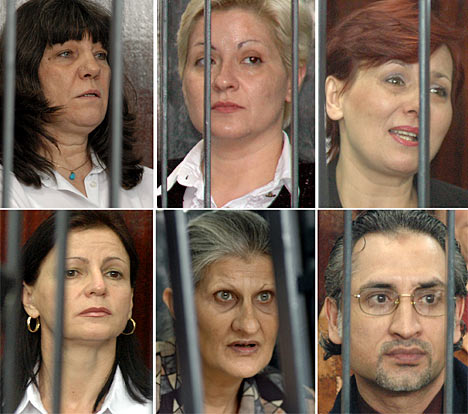
© Renaud Vigourt (Website | Twitter)
Governments around the world were slow to get to grips with HIV/AIDS. But a big change came when they started understanding it not just as a health issue but as a security threat too. Alexandra Ossola investigates.
Richard Holbrooke sat in a blue striped chair in the meeting room of the United Nations Security Council. It was a rainy, unseasonably warm January day in New York City, just ten days into the new millennium. Many people were still relieved that the Y2K millennium bug hadn’t wreaked havoc on computers, as some experts had feared. And yet, during the council’s seven-hour meeting, it was clear that a bigger, real threat was looming.
Doctors had identified HIV/AIDS more than 15 years before, but only by 2000 was its true global impact beginning to become clear. Holbrooke, the US ambassador to the UN, then sitting as president of the Security Council, had pushed for this meeting because he had seen first-hand how AIDS could devastate communities. In 1992, he had visited Cambodia and saw UN peacekeepers who, at the end of the day, would get drunk and visit brothels. Holbrooke was sure this behaviour was spreading HIV locally, and that the peacekeepers would bring the disease back with them to their home countries.
He had seen the impact even more dramatically in 1999, when he and his wife visited Africa. Children whose parents had died of the disease slept in gutters; even AIDS activists were so stigmatised they arrived to meet him in a curtained van. Conversations with leaders in countries like Namibia and South Africa showed Holbrooke they weren’t doing nearly enough to combat the disease. The trip galvanised him. AIDS was spreading, regardless of borders, in a way that threatened the stability of states. So, if national governments weren’t taking action, perhaps the world could.
But Holbrooke was met with resistance. Congressmen criticised him on television; friends and dignitaries warned him privately not to confuse humanitarian issues with national security. How could a disease be an issue of national security, they argued – no disease ever had been. “I was told by everyone, including my own staff, ‘You can’t do this; it’s not done; it’s not in the UN charter,’” Holbrooke said in a 2006 interview with PBS. “And I said, ‘But AIDS is a security issue, because it’s destroying the security, the stability of countries.’”
Luckily, Holbrooke found the Security Council more amenable as he pushed to discuss HIV/AIDS. Only Russia was opposed, which Holbrooke thought was ironic since the prevalence of HIV/AIDS in Russia and its surrounding countries was rising rapidly.
Eventually, Holbrooke prevailed. Russian representatives agreed to sit in on the meeting, but wouldn’t speak or participate. That suited Holbrooke just fine. And on 10 January 2000, representatives from all 15 countries took their blue seats in the Security Council meeting room to hear 40 speakers discuss the threat and impact of HIV/AIDS.
AIDS became the first epidemic in modern history to morph beyond a topic of public health into an issue of national and even international security. Without collaboration between countries, between scientists and military personnel, between industry and government, the disease would have claimed more than the 35 million lives it has to date.
There are other events that could qualify as turning points in the fight. The 2000 conference held in Durban, South Africa, at which Nelson Mandela delivered a heartfelt appeal to the international community. Or the 2002 G8 summit in Alberta, Canada, at which global leaders rolled out a plan to support Africa, in it mentioning their dedication to eradicate HIV/AIDS. Or 1987, when the US Food and Drug Administration announced AZT as the first approved treatment for HIV, due in large part to lobbying from gay activists. Or 1995, when the agency approvedHAART, the drug cocktail that most people with HIV/AIDS take every day to stop the progression of the disease.
But the Security Council meeting was critical. The meeting on that balmy January day marked the first formal discussion of HIV as an issue in which the government and military must get involved to protect a country and its interests. Seven months later, the Security Council passed a resolution calling for more training in AIDS prevention for UN peacekeeping forces and encouraging member states to work together for better prevention and treatment policies.
The rhetoric of national security has shaped the way activists and officials address epidemic diseases today, solidifying partnerships and funding streams. And though there are clear advantages to this large-scale, top-down approach of military involvement, there is much to learn about the best way to stop a pandemic.

© Renaud Vigourt (Website | Twitter)
By the early 1980s, diseases that ravaged the human population seemed like they might become a thing of the past. Smallpox had been eradicated worldwide by 1980; vaccination campaigns during the 1960s and 70s meant that diseases like polio, mumps and measles affected far fewer people. “People were talking about conquering infectious disease once and for all,” says Joshua Michaud, the associate director of global health policy at the Kaiser Family Foundation. “Nobel Prize-winning biologists were saying that we could see the end of infectious disease in our lifetime, and there were reasons to believe that.”
But when AIDS was discovered in 1981, that illusion was shattered. “We had a lot of magic bullets, we had technical fixes to everything. Then HIV happened,” Michaud says.
HIV/AIDS made for a scary assailant. It surfaced mostly among gay people in San Francisco and New York, a death sentence that catalysed activism among the gay community. This activism became critical in helping people gain access to experimental treatment. HIV became highly stigmatised, a “moral” disease, a plague of philanderers and drug addicts.
The disease hits hardest among adults of reproductive age who are otherwise healthy. It’s a threat that respects no border, as George Tenet, then director of the CIA, noted in 2003. And though the effects of AIDS can feel overwhelming when concentrated within communities, they are even more disastrous when taken at a macro scale.
“AIDS is a long-wave event,” says Simon Rushton, a lecturer in politics at the University of Sheffield. “It’s cross-generational. The impacts on societies are long-term, and they accumulate over time.”
More people would die from AIDS than from any other disease outbreak in human history, including the global influenza pandemic of 1918–19 and the bubonic plague in the 1300s, wrote Peter W Singer, then a postdoctoral fellow at the Brookings Institution, in a 2002 essay. If the disease continued to spread at the same rate in places like South Africa and Botswana – where 20 per cent and 38.5 per cent of the population respectively was infected in the year 2000 – life expectancies would plummet by more than 20 years and child mortality would triple within a decade, Singer said.
Intelligence experts estimated that AIDS would wipe out a quarter of all adults in Sub-Saharan Africa.
“[They] were making a logical case that this was going to keep getting worse and worse, that it will threaten viability of most infected states,” Rushton says. Researchers were struggling to understand the epidemic. “There was a fear, perhaps a well-grounded fear.”
Effects like that would put the political stability of these countries at risk, argued innumerable reports and assessments.
The disease would wipe out government officials and educated, trained professionals that make up the backbone of a society, leaving elderly people to care for orphaned children, a process the experts called “hollowing out”. Militaries, which have higher infection rates than civilian populations (in theory because as young, virile men move around, they engage in sexually risky behaviours, swapping diseases with locals and bringing them to the next deployment), would crumble. Destabilised states leave room for extremist groups to take hold, powered by armies of child soldiers under the command of some of the surviving adults.
This worried American intelligence officials. The US would be called upon to provide costly aid to failing states, according to a declassified CIA report from 1987. The Soviet Union would threaten the US’s strategic positioning in Africa – a key concern during the Cold War – by encouraging rumours that American scientists had created HIV and were spreading it throughout the continent to eliminate black people. The disease also seemed likely to spread to places considered geopolitically more important, such as India and China. The Cold War ended, but, as the epidemic persisted after 9/11, the potential rise of more extremist groups seemed even more threatening. Of course, US officials also feared the disease taking a stronger hold at home, affecting more than those groups relegated to society’s fringes. It could weaken the military and put America’s own stability at risk.
Intelligence agencies had been predicting the destabilising effects of AIDS since the 1980s, yet the world didn’t present a cohesive response until 2000. There’s no single reason why it took so long, but one was that the science on treatment and prevention was still murky, says Mitchell Warren, the executive director of AVAC, a global HIV/AIDS advocacy organisation. By the late 1990s, scientists had shown it was possible to treat and prevent the disease, which was enough to spur activists and political leaders to act. Short of a cure, the only way to stop the epidemic from ballooning was prevention.
§
A 25-year-old woman living in rural Malawi found herself very ill. She had shingles and malaria that wouldn’t go away; her weight had dropped precipitously. Though programmes to diagnose and prevent HIV had been running in the country for several years, this woman had never been tested, and neither had her four-year-old son. “She was living in denial, she didn’t want to discover she was HIV positive,” says David Odali, the director of the Umunthu Foundation, a non-profit that offers HIV testing and treatment and runs education campaigns in Malawi. The woman’s family encouraged her to go to Umunthu’s clinic in the small town of Bangwe, where both she and her son tested positive for HIV and started receiving treatment.
It saved her life; in the years since, the woman has had two more children, both of whom are HIV negative. The mother is able to do some work, more than she could do when she was ill, and the son is thriving in school. “He’s brilliant in school,” Odali adds. “He does come here sometimes on his own to get his treatment,” though his mother only recently helped him to understand why he was taking medicine every day when he didn’t feel sick.
Cases like this one are no longer uncommon. There’s no denying the huge impact that AIDS has had on the world population – in 2015, the World Health Organization (WHO) estimated that about 70 million people have been infected with the virus, and 35 million have died. And yet the effects have not been as dire as once feared; in 2001, experts predicted that 100 million would be dead from the disease by 2005.
Bold, creative individuals – scientists, activists, NGO workers, healthcare professionals – made this happen. But they wouldn’t have been there, their organisations unfunded, the research not conducted, without support from national governments.
The US government, for instance, allocated $6.6 billion to fight HIV/AIDS abroad in 2016 (independent of the $26.4 billion it spends on domestic programmes), making its budget many times larger than those of the UK, which allocated $980 million to fight AIDS in 2015, and Germany, at just over $200 million.
The bulk of the US money comes under the President’s Emergency Plan for AIDS Relief (PEPFAR), and trickles down through different government departments, such as Defense, State, and Health and Human Services, and diffuses into smaller agencies and non-profit organisations, or directly to foreign governments for their own treatment and prevention programmes, says Warren. About a fifth is carved out for the Global Fund. “Both of these organisations were the result of this call in 2000 of a need to change the way the world responded to HIV,” Warren says.
To Warren, it’s clear that the response would not have been as robust if HIV had not been considered a matter of national security. The reframing compelled tight-fisted government officials to make room in the budget. “At the end of the day, the most important people at the country level were not ministers of health. They’re ministers of finance,” Warren says.
The security dimension makes it a bigger political issue than public health, Simon Rushton says. It’s high politics. Peter Piot, who was director of UNAIDS for 13 years, says that this helped establish HIV/AIDS as an exceptional epidemic, requiring an unprecedented level of resources and coordination across sectors.
This produced real results. More than 18 million HIV/AIDS patients worldwide were receiving treatment in 2016, and the number of new cases per year dropped by 40 percent between 1997 and 2015.
It’s impossible to know what would have happened if the national security appeal hadn’t had this effect. As Warren puts it, if something didn’t happen, they’d succeeded. Some feared that the framing would divert funds from other public health issues, such as tuberculosis and malaria. Others said it would further stigmatise people. In Europe and Russia, for instance, people from Africa already faced discrimination in housing and the job market because they were feared to carry disease. The same happened to Haitians in the US.
And though it pulls in more money in the short term, framing one disease as a security issue may absolve countries from engaging with future epidemics that don’t present a security risk, wrote Susan Peterson, a professor of international relations at the College of William and Mary in Williamsburg, Virginia, in 2002.
The security framing may also shift the focus of the HIV/AIDS spending itself. When PEPFAR launched in 2003 with a budget of $15 million, its efforts initially focused on 15 countries. These were not the top 15 countries affected by AIDS at the time. “People have looked at that initial list,” says Rushton, “and it looks like it’s at least partly motivated by security concerns.” He notes that Vietnam, one of the 15 countries on the original list, had only 220,000 cases of HIV/AIDS in 2004 – a mere fraction of the number of people infected in Malawi (940,000), which did not receive initial attention from PEPFAR, and far less than Russia (more than 320,000), which similarly received no support.
And though countries like South Africa were at the centre of the AIDS epidemic and deserved the funding and attention they received, critics have suggested that global powers, including the US, might have been more invested in their political stability.
David Odali still struggles to get enough funding for Umunthu’s ambitious programmes, although a six-year partnership with the NGO AVERT has enabled them to reach out to more patients. Though he and his collaborators have had many successes, there were still 33,000 new cases of HIV in 2015 in Malawi. “As we are talking, someone out there is contracting the virus, through unprotected sex, through rape, through caring for a patient,” he says. “The infection is still there with us.”
§
When West Point was first dredged from the sea, in the 1940s, it was probably a beautiful place. This neighbourhood at the most northwestern point of Monrovia, Liberia, is a peninsula, cut off from the rest of the city by two rivers to the north and east, and with the Atlantic Ocean to the west. Its beaches are a sandy yellow, and a few palm trees dot the shore. But today, that beauty is only visible in fleeting moments, like afternoon light through slanted blinds. West Point is a slum, home to 75,000 people who live in densely packed houses cobbled together from roofing tin. Its beautiful beaches are coated with a layer of garbage. Many former child soldiers, disabled by war, live here; drug use is common. There is a market on the one main road that connects the neighbourhood with the rest of the city, on which patrons can buy shark freshly caught by the fishermen who shove off the beaches in long, narrow boats.
Since there’s only the one road, it wasn’t hard for the Liberian army to quarantine the neighbourhood one cool night in the heat of the Ebola crisis in August 2014. The week before, health officials quietly converted a school building into an Ebola holding centre; when the locals found out, some looted the facility, carrying off items that had likely been contaminated. So when the Liberian president issued a curfew on 20 August, West Point was also put under quarantine. Residents awoke that Wednesday morning to find their commutes thwarted by barbed wire; fishermen were stopped from pushing off in their boats.
The locals rioted. They rattled barricades and threw rocks at soldiers, who responded by opening fire. Food and water were hard to find, medical care was even rarer. After 10 days, the president lifted the quarantine. A 15-year-old boy died of complications from bullet injuries in his legs. “You fight Ebola with arms?” a 34-year-old resident yelled at the soldiers, according to the New York Times. No one in West Point was diagnosed with Ebola.
In the wisdom and comfort of hindsight, experts can assess the world’s response to emerging pandemics. The 2009 H1N1 (swine flu) outbreak was well-contained, partly because of good communication and partly due to simple luck: the disease wasn’t as deadly as feared. The Middle Eastern respiratory virus (MERS), which hit South Korea in 2015, didn’t spread because it didn’t evolve and was quickly contained.
But to many experts, the world’s response to Ebola was wanting. Public health officials admit that action wasn’t fast enough, that misinformation spread quickly among a largely illiterate population, that foreign policy makers lacked a cultural understanding, which allowed the disease to spread, and that governments in the most affected countries used too much force. As a result, more than 11,000 people died of the disease in West Africa.
And yet the death toll would have certainly been higher if not for the lessons learned from HIV.
The engineers of the world’s HIV response in the early 2000s knew that they were laying the groundwork to combat future epidemics. Richard Holbrooke, who died in 2010, said in his 2006 PBS interview: “There’s a possibility that we’re entering into an age where new diseases are beginning to break out… If that’s true – and a lot of friends of mine in the field think it is true – the first lesson is you’ve got to move really fast. The second lesson is you have to get away from mythology, stigmatisation and all these other things that created such a slow, slow reaction to AIDS.”
Because of HIV and those discussions that began in 2000, governments and international organisations have logistical protocols to address new epidemics. Emerging diseases are now discussed at the Security Council, as AIDS was. Should a new one arise, officials in the US government, along with international organisations such as the UN and the WHO, have designated procedures for assessing the threat and working with experts on the best way to respond. Time, they have learned, is of the essence – the slow growth of HIV diagnosis programmes meant that many people spent a long time unknowingly infected – during which time they infected others; physician and radio show host Stanley Monteith wrote in 1997 that the AIDS epidemic would have been preventable had health organisations acted earlier.
Now experts know that early response is key. By April 2003, six months after the severe acute respiratory syndrome (SARS) epidemic started, the US had 289 suspected cases, But the disease didn’t spread because of good planning and communication between local and federal health workers, public health officials told the New York Times. And the impetus for that was laid in the framing of the disease as a threat to national security.

© Renaud Vigourt (Website | Twitter)
In the process of meeting the need for HIV testing and treatment in remote areas, many African countries developed sophisticated systems to monitor emerging diseases. Ebola would have been a disaster if it had spread throughout Nigeria, the most populous country in Africa and a hub for international travel. But it didn’t, Warren says, because of systems put in place to combat HIV which were then used to fight Ebola. “The surveillance system and treatments of those Nigerians with Ebola was so rapid that the disease didn’t spread,” Warren says. “If you look at why, it’s because the health system had been developed and strengthened from the HIV response.”
Researchers are also in a better position to meet the challenge of a new infectious disease. Epidemiologists developed new techniques, such as contact tracing, in which scientists work backwards from a newly diagnosed patient to determine where else the disease might spread. Teams of scientists brought together to discover treatments for HIV have used their expertise to treat other rapidly mutating diseases – a team of HIV researchers at Walter Reed Army Institute of Research, based in Maryland but with facilities in Africa and South-east Asia, created one of the most promising vaccines to fight Zika virus. And when it comes to disease research within communities, scientists have found that they get much more cooperation if they work with local governments and community advisory boards before starting a project.
Charged by the national security argument, militaries – especially the US military – have become the quickest and most efficient force for quelling emerging infectious diseases. “The only institution that was felt could address Ebola at the scale at which it was needed was the US military,” Joshua Michaud says – the army had the communication, infrastructure and transportation to get the job done.
But that can come with a cost. The need to act quickly can sometimes elevate issues past the normal democratic checks and balances, so they are subject to less scrutiny. When security is at risk, it gives militaries licence to infringe on civil liberties. That’s what happened to West Point during the Ebola outbreak. It happened elsewhere, too – in the US, many questioned the quarantine practices of the Centers for Disease Control and Prevention. One woman, a nurse quarantined for two days after she returned from treating Ebola patients in Sierra Leone, tried to sue the governor of New Jersey for unlawful detainment (a judge dismissed the lawsuit in September 2016).
“One downside is that the security discourse can be misappropriated by those in power and used improperly to justify punitive policies and laws, which are only likely to fuel stigma, fear and spread of disease further,” Peter Piot says. “The military has a role to play, we just have to think in a considered, nuanced manner about how they can best support civilian-led efforts to contain pandemics.”
Each new pandemic will be different – where it starts, how contagious it is, how it’s transmitted. But as government agencies push to act quickly, more officials are realising that the first actions taken to fight a disease can determine whether the efforts are successful. If misinformation spreads early on, it can lead infected people to be stigmatised, which may inhibit them from receiving the best possible care. Warren recalls photos from the early days of the fight against Ebola in which healthcare workers were reluctant to touch patients.
“For a lot of us working with HIV, some of those pictures were harsh reminders for what it meant to be patient-centred in our care,” Warren says. “The stigma and culture around disease, around clinical research, is really intense. We need to be sensitive to that.” Public health workers had collaborated with community leaders before, but they had never tried to create these partnerships on such a massive scale until the HIV response. Ceremonies surrounding stages of life, such as birth and reaching sexual maturity, create different ways for disease to spread. Only with sensitivity to local cultural practices – what purpose they serve, and how they can be modified while still keeping the main point of the ritual intact – could doctors and researchers stop the spread of disease. Officials were faced with a similar challenge during the Ebola epidemic, when they discovered that traditional burial practices, such as the communal washing and cleaning of the dead body, were spreading the infection.
§
Public health emergencies come and go, but HIV appears to be here to stay, at least for the next few decades. Some fear that, as health workers settle in for a long fight, governments will no longer prioritise HIV as they did a decade ago, limiting the funding to support their efforts. Progress in reducing the number of new infections has slowed. “AIDS is slipping down the policy agenda because we’re also now in the long slog phase,” Simon Rushton says. “We know it’s not something that will be solved in the next five to 10 years – it demands a continued commitment for another 20 to 30 years at least. That’s a much less sexy policy sell. Policy makers like problems they can solve during their term.”
With the election of Donald Trump as President of the United States, the country’s role in the continued fight against HIV/AIDS is further called into question. During much of Trump’s campaign, no one was certain where the candidate stood. There were reasons to feel optimistic about the country’s continued support. In a 2008 speech, Vice President Mike Pence, then serving in the House of Representatives, had said that the US had a “moral obligation to lead the world in confronting the pandemic of HIV/AIDS”, bolstering his stance with a security argument.
But early signs from the new administration have not been heartening. In his first week in office, Trump signed an executive order that withholds funding from organisations that perform abortions or provide information about them. In the past, similar but less expansive policies have resulted in the closure of many rural clinics, often the only place where locals could receive drugs to treat HIV and AIDS. Now many organisations fear the effect will be even more dramatic.
In some ways it’s harder than ever to imagine a world in which infectious diseases no longer exist, the idealistic bubble burst by HIV. And yet in other ways, the world is better poised than ever before to make that fantasy into reality. That single January 2000 meeting set the stage for leaders within countries to have their own discussions about how to respond to the epidemic, about how to spend money to counter it within their own borders and beyond.
As the then US Vice President Al Gore said at the meeting, AIDS “is a security crisis because it threatens not just individual citizens, but the very institutions that define and defend the character of a society”.
“It was one of the most exciting days we had in the UN,” Richard Holbrooke told PBS, “and I think history shows that it helped redefine the issue.” 
This article first appeared on Mosaic and is republished here under a Creative Commons licence.
Thanks for reading, let us know what you think in the comments below, or you can find us on Facebook, Twitter or Instagram!


















